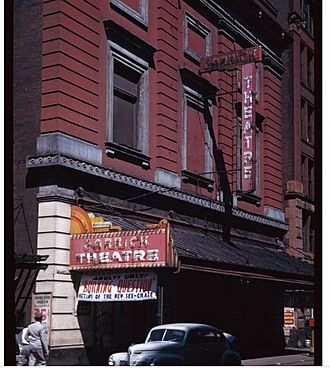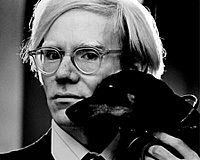Garrick Cinema facts for kids
The Garrick Cinema was a movie theater in New York City. It was located at 152 Bleecker Street in the Greenwich Village area. This theater had 199 seats. In the late 1960s, the famous artist Andy Warhol showed many of his films here.
Below the theater, in the basement, was a popular nightclub called the Cafe Au Go Go. This club hosted many well-known music groups, folk singers, and comedy acts. The Garrick Cinema building was taken down in the 1970s.
Contents
Andy Warhol's Films at the Garrick
Andy Warhol was a very famous artist. In the 1960s, he had a studio called "The Factory". He worked with many assistants and friends there. They helped him create his art, including silkscreen prints and films. Some of his important helpers were Gerard Malanga, Ondine, and Billy Name.
Warhol also had a group of creative and unique friends he called "superstars". These included people like Edie Sedgwick, Nico, and Viva. Many of these "superstars" acted in the films made at The Factory. Important artists from the New York underground art scene, like poet John Giorno, also appeared in Warhol's movies.
Many of Andy Warhol's films were first shown at the Garrick Cinema. Some of these films included Bike Boy (1967), Lonesome Cowboys (1968), and Loves of Ondine (1967). Other films like ... Movie (1969) and ... (1968) also premiered there.
Frank Zappa and The Mothers of Invention
The famous musician Frank Zappa and his band, the Mothers of Invention, played many shows at the Garrick Cinema. They performed there almost every night for six months in 1967.
Frank Zappa needed a place to play in New York City. His manager, Herb Cohen, helped him rent the Garrick. The band's shows were called "Pigs & Repugnant." They mixed long musical pieces with funny and unusual theater acts. These shows were a live performance of their second album, Absolutely Free.
Other musicians also opened for The Mothers of Invention during this time. These included Tim Buckley, Richie Havens, Eric Andersen, and Meredith Monk.
The Cafe Au Go Go Nightclub
The Cafe Au Go Go was a well-known nightclub. It was located in the basement of the Garrick Cinema building on Bleecker Street. The club was open from February 1964 to October 1969. It was a very popular spot in Greenwich Village.
Many famous musicians and comedians performed at the Cafe Au Go Go. It was the first place in New York City where the Grateful Dead played. Other regular performers included Richie Havens and the Blues Project.
Many legendary artists played there, such as Jimi Hendrix, Van Morrison, Joni Mitchell, Judy Collins, Howlin' Wolf, Muddy Waters, John Lee Hooker, The Doors, and Cream. Before rock bands became popular there, the club was known for jazz music, comedy acts like Lenny Bruce and George Carlin, and folk music.
What's There Now
The Garrick Cinema and the Cafe Au Go Go buildings were torn down in the 1970s. Today, at 152 Bleecker Street, there is a mid-rise apartment building. On the ground floor of this building, there is a Capital One Bank branch.
See also
- Bleecker Street Cinema – another nearby theater
- 55th Street Playhouse – another theater that showed Warhol films
- The Factory – Andy Warhol's famous studio



